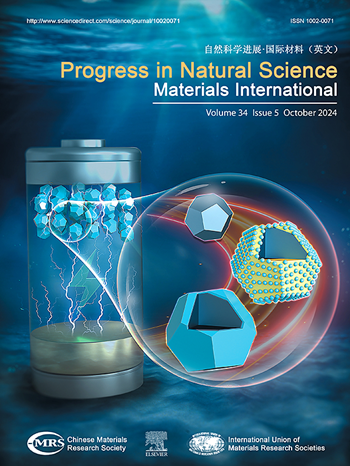Dual effects of Co on microstructure stability in a Ru-containing Ni-based single crystal superalloys
IF 7.1
2区 材料科学
Q2 MATERIALS SCIENCE, MULTIDISCIPLINARY
Progress in Natural Science: Materials International
Pub Date : 2025-04-01
DOI:10.1016/j.pnsc.2024.12.009
引用次数: 0
Abstract
The guarantee of microstructure stability of a Ru-containing Ni-based single crystal superalloys (Ni-SXs) is key for prolonging the service life. As a potential substitute for Ru, the effects of Co on microstructures stability of a 4th generation Ni-SXs, including the precipitation of topologically close-packed (TCP) phases, coarsening of γ′ phase and surface oxidation after heat exposure at 1100 °C, are studied. The results show that Co has dual effects on the precipitation of TCP phases. It is inhibited inside Ni-SXs due to the decrease of concentration in Re, Cr, Mo, and Co in γ matrix. But the inhibition is alleviated to precipitate TCP phase in near-surface microstructures of the Ni-SXs containing 9 wt% Co after consumption of Co addition by the oxide. Therefore, a small amount of TCP phases precipitates in advance at the near-surface of the Ni-SXs. The increase of Co3O4 and NiCo2O4 with Co addition destroys the barrier of the continuous oxidation layer and goes against oxidation resistance. On the contrary, the increase of Co decelerates the coarsening of γ′ phase at internal Ni-SXs, which is conducive to microstructures stability.
Co对含ru镍基单晶高温合金组织稳定性的双重影响
保证含钌镍基单晶高温合金(Ni-SXs)显微组织的稳定性是延长合金使用寿命的关键。作为Ru的潜在替代品,研究了Co对第4代Ni-SXs的微观组织稳定性的影响,包括拓扑紧密堆积(TCP)相的析出、γ′相的粗化和1100℃热暴露后的表面氧化。结果表明,Co对TCP相的析出有双重影响。γ基体中Re、Cr、Mo和Co的浓度降低,抑制了Ni-SXs内部的反应。但当Co添加量为9wt %的Ni-SXs的氧化物消耗掉Co后,其近表面组织中TCP相的析出抑制得到缓解。因此,少量TCP相在Ni-SXs近表面提前析出。Co3O4和NiCo2O4随着Co的加入而增加,破坏了连续氧化层的屏障,不利于抗氧化性。相反,Co含量的增加减缓了Ni-SXs内部γ′相的粗化,有利于组织的稳定。
本文章由计算机程序翻译,如有差异,请以英文原文为准。
求助全文
约1分钟内获得全文
求助全文
来源期刊
CiteScore
8.60
自引率
2.10%
发文量
2812
审稿时长
49 days
期刊介绍:
Progress in Natural Science: Materials International provides scientists and engineers throughout the world with a central vehicle for the exchange and dissemination of basic theoretical studies and applied research of advanced materials. The emphasis is placed on original research, both analytical and experimental, which is of permanent interest to engineers and scientists, covering all aspects of new materials and technologies, such as, energy and environmental materials; advanced structural materials; advanced transportation materials, functional and electronic materials; nano-scale and amorphous materials; health and biological materials; materials modeling and simulation; materials characterization; and so on. The latest research achievements and innovative papers in basic theoretical studies and applied research of material science will be carefully selected and promptly reported. Thus, the aim of this Journal is to serve the global materials science and technology community with the latest research findings.
As a service to readers, an international bibliography of recent publications in advanced materials is published bimonthly.

 求助内容:
求助内容: 应助结果提醒方式:
应助结果提醒方式:


